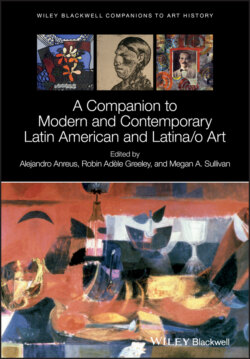Читать книгу A Companion to Modern and Contemporary Latin American and Latina/o Art - Группа авторов - Страница 30
Notes
Оглавление1 1 First published in Barcelona in 1925. The edition I used is La raza cósmica: misión de la raza iberoamericana; Argentina y Brasil (Vasconcelos 1948, pp. 16, 42–43).
2 2 I thank Robin Greeley for providing me with the correct dating of these drawings.
3 3 The details of Orozco's politics in this section come from Alejandro Anreus, “Los Tres Grandes: Ideologies and Styles,” in Anreus et al. (2012), pp. 40, 43.
4 4 El Machete No. 7 (June 1924), Mexico City. I here use the translation and edited version by Alejandro Anreus in Anreus et al. (2012), pp. 319–321.
5 5 See Coffey (2007) for a deep consideration of this topic. This publication is a much‐needed updating of the scholarship on Tamayo and features essays by such luminary scholars as Coffey, Olivier Debroise (to whose memory I dedicate this essay), Du Pont, Anna Indych‐López, James Oles, Karen Cordero Reiman, and Adriana Zavala. The chronology and the bibliography are comprehensive.
6 6 See Campbell (2003) for a comprehensive treatment of these many examples of “unauthorized” muralism.
7 7 Illustrated in Resisting the Present: Mexico, 2002/2012 (2011, pp. 38–39), a fantastically interesting catalog for the exhibition of the same name.
8 8 See also James M. Wechsler, “Propaganda Gráfica: Printmaking and the Radical Left in Mexico, 1920–1950” and “Taller de Gráfica Popular: the Life and Drama of Mexico,” in Ittmann (2006), pp. 55–79 and 208–223 respectively.
9 9 See Flores (2013) and “Murales Estridentes: Tensions and Affinities between Estridentismo and Early Muralism,” in Anreus et al. (2012), pp. 108–124.
10 10 Changes in art historical approaches to our topic have been indicated clearly to me, as colleagues have challenged my findings in at least two cases, which I document here, as such incidents mark the progress of the field. Jennifer Jolly respectfully disagrees with me on points of interpretation in her “Two Narratives in Siqueiros' Mural for the Mexican Electricians' Syndicate,” Crónicas: El muralismo, producto de la revolución mexicana, en América (March 2001–February 2002), pp. 99–118, see pp. 105 and 110. Mary Coffey convincingly takes issue with my approach to state patronage and to the formation of viewing subjects in Coffey, M. (2012). How a Revolutionary Art Became Official Culture: Murals, Museums, and the Mexican State, pp. 15–16. Durham and London: Duke University Press. These references are meant to acknowledge that scholarship in any field is a fluid and dynamic phenomenon, and that scholars need to continue corresponding about methods and findings.
